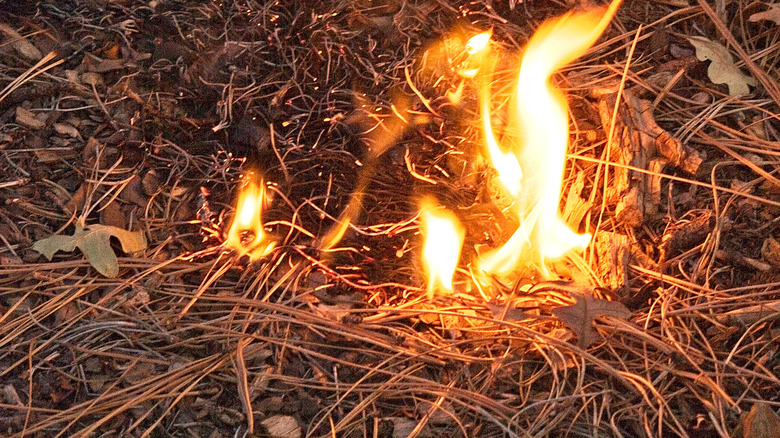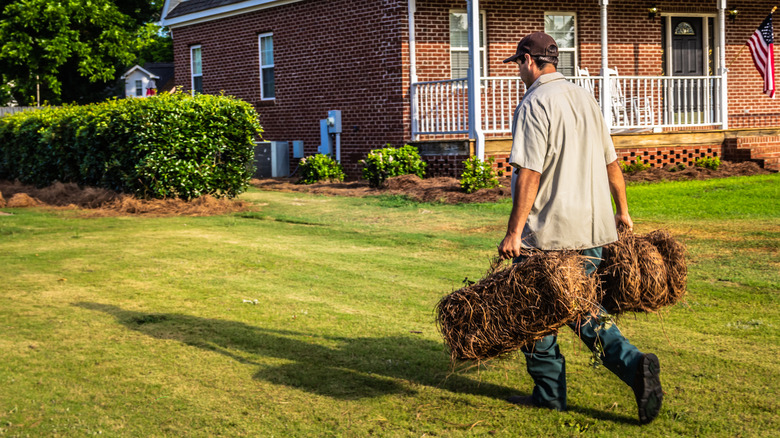The festive season is almost upon us, and while others are thinking about gift lists and photos with Santa, gardeners are wondering what kind of second life to give their real Christmas trees. To compost or not to compost it? Those fallen pine needles make for great mulch, right? Pine needles, also commonly known as pine straw, have been a popular mulch material in the southern U.S. states since the 1980s. They have a lot of well-documented positives, from weed suppression and sustainability to longevity and attractiveness. Conversely, the Internet also abounds with warnings: pine straw acidifies your soil, contains plant-harming toxins, harbors pests, reduces water retention, and increases fire risk.
Expert sources suggest using pine straw to mulch acid-loving (ericaceous) plants, like rhododendrons, azaleas, camellias, blueberries, heaths, and heathers. The advice goes that since pine needles boast low pH levels, they add acidity to the soil as they break down. In actuality, while fresh-fallen, green needles have a pH of 3.2 to 3.8, as they turn brown and decompose, their pH values shift, rendering them neutral. The list of plants that will thrive under a pine tree isn’t that long, true. However, this is more likely due to shade and their shallow root systems creating competition for soil resources. The tree species pine straw is typically harvested from — longleaf, slash, and loblolly — grow where they do because the soil is already acidic.
Terpenes, pests, and fires

While the acidity of pine needles likely isn’t a problem, they also contain terpenoids. These allelopathic compounds inhibit plant growth and seed germination and give your Christmas tree that distinctive festive smell. However, according to a 2005 study published in the HortScience, fresh needles have the most terpenes and, therefore, the most notable effect. Pine straw is made of dried needles, so no worries there. Growth inhibition is a bonus if you’re mulching to reduce weeds.
Some experts advise against harvesting wild needles because you could transplant red fire ants or termites to your property — especially if you live in the South. Critters like raccoons and skunks love pine straw mulch for the tasty insects that reside beneath. If your mulch looks swirly each morning, you know they’ve snuffled around overnight. Needle blight, a fungal disease that occasionally survives in fallen straw, only infects pine trees; there’s no evidence it infects other plants. The solution to that problem is easy — don’t collect needles underneath blight-stricken trees.
There’s no denying that pine needles are worryingly combustible. If you live in a part of the country prone to forest fires, this is a genuine reason to reconsider using pine straw as a mulch material. Just as the tall pine trees you should grow in your yard need to be planted far from habitable buildings, municipal authorities also advise keeping an area 10 to 30 feet from your home clear of needles.
Best practices

Using pine needles as mulch is far from a bad decision. Generally, the positives far outweigh the negatives if you stick to some gardening best practices. If you’re still worried about some of the purported ill effects of using pine straw, like it adding too much acidity to the soil, then layer some compost underneath your pine needle mulch. You can also dress your soil with lime to combat any perceived (or, ideally, tested for) acidity. Putting down too thick of a layer of pine needles can create a waterproof barrier. Aim for a layer that’s 4 to 6 inches thick. Add more straw each year to replace the decomposed material, and, due to the growth-inhibiting terpenes the needles contain, pull back the straw in the spring to ensure self-seeded perennials and overwintered annuals pop back up.
Collect pine straw yourself for free. Pine trees shed needles all year round, but fall to early spring is when they drop the most. Create a pile in a forgotten part of your yard to draw from in the spring and summer months. Alternatively, you can buy locally harvested straw from big box retailers and specialist landscape suppliers alike. Walmart has 2.3 cubic feet of CleanStraw longleaf pine straw for $45.55. Get bigger-sized 9 or 14-inch premium pine needles from USA Pinestraw, which has a 300-square-foot box for $149.99 on sale. Colored Pine Straw has crimson-hued longleaf pine straw 100 to 125 square foot rolls for $69.95.



